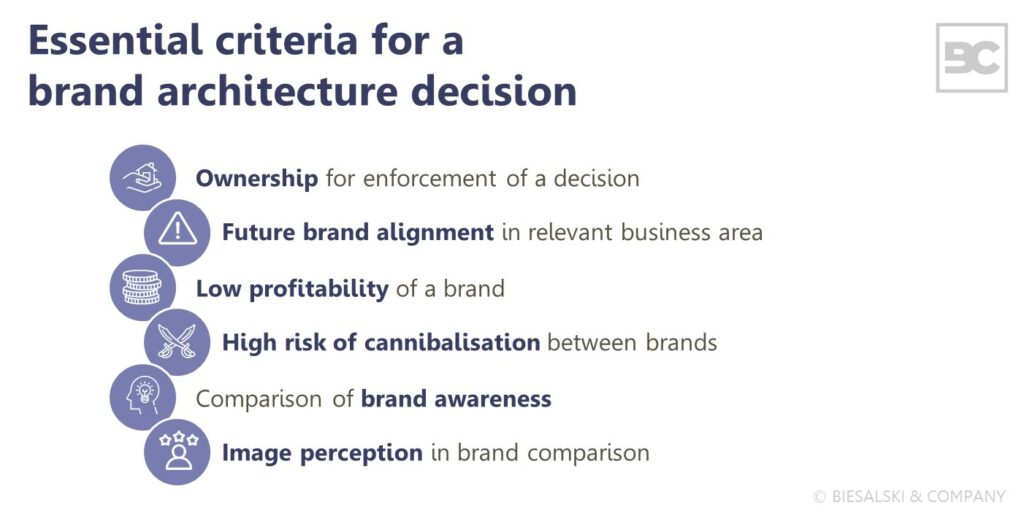Brand portfolio and
brand architecture
Brand strategy
Brand portfolio and
brand architecture
Brand identity and positioning
Brand concretisation
Customer journey mapping
Communication idea
Brand-driven innovations
Brand architecture: optimisation of the brand portfolio according to efficiency and profitability
“One brand means one company. Two brands mean two companies“. These were the thoughts of the founding father of brand consideration – Hans Domizlaff – a couple of years ago. Even though he was right about nearly all of his thoughts and statements regarding the subject “brand”, there was a lot of change in relation to having several brands within one company in the last 70 years.
Many things that simply did not exist during the times of Domizlaff, are common practice nowadays and require an intensive confrontation when designing the brand portfolio:
- Post-merger integrations
- Designing cooperations or joint ventures for the common brand image
- Deciding on a branding strategy
- Transparent structuring of the product range in a way that is understandable and transparent to the target group, with the aim of reducing complexity and thus improving their understanding
- Extending the distribution
- Brand expansion on a product, market, target group and price positioning scale
- Strategic reorientation regarding the solution portfolio
- Transforming the business models
Besides the above-mentioned reasons, there are also many different goals that can be pursued with the revision of the brand portfolio. In general, the aim is to specify the hierarchical and functional order within the brand system. A manageable brand architecture should be developed that makes the ideal naming and brand decisions, taking into consideration corporate policy requirements as well as return and cost considerations.

Another possible goal can be the adjustment, expansion or optimisation of the portfolio. Alternatively, the aim may be to increase efficiency or profitability within the whole offer and brand portfolio.
Fundamentally, you should include the support of strategic corporate goals as well as brand strength, fit and potential when considering your portfolio and architecture. Besides cannibalisation effects and trends in the target groups, participation interests can also exert a significant influence on the design of the portfolio and architecture.
What we offer
When revising and optimising a brand portfolio and brand architecture, the following steps proved effective:
- Analysing the strengths and weaknesses of the current architecture and deriving recommendations for the future brand order
- Applying fact-based decision models for subjectively led brand discussions
- Determining a binding architecture for all product fields, regions and target groups
- Comparing the future target architecture with the current structure and organisation
- Defining the specifications to apply to umbrella and product brands and adapting the brand structure for future business segments
- Visualising the architecture and brand interfaces
- Identifying business segments with a high brand fit and competence to increase success at market entry
- Segmenting the target group in accordance with its attitude and behaviour towards the brand
Your benefit
An ordered and structured brand portfolio provides a solid base to secure the future market position and grow further. The brand system is transparently ordered both on a hierarchal level as well as across business segments, regions or target groups and serves as stable structural frame to further develop the brand.
This offers security when making decisions about current and future brands. You have a clear guideline when introducing new brands and products, but also a firm argumentation aid when talking to internal and external stakeholders. Consequently, there is transparency regarding the profitability of company/individual brands and of the portfolio as a whole, while also allowing you to economically operate in a more sustainable and efficient way.
As a result, clear rules for the brand portfolio and brand architecture help you to make decisions that are often rather emotional in an objective, transparent way.
Contact me!
Alexander Biesalski
MANAGING PARTNER

